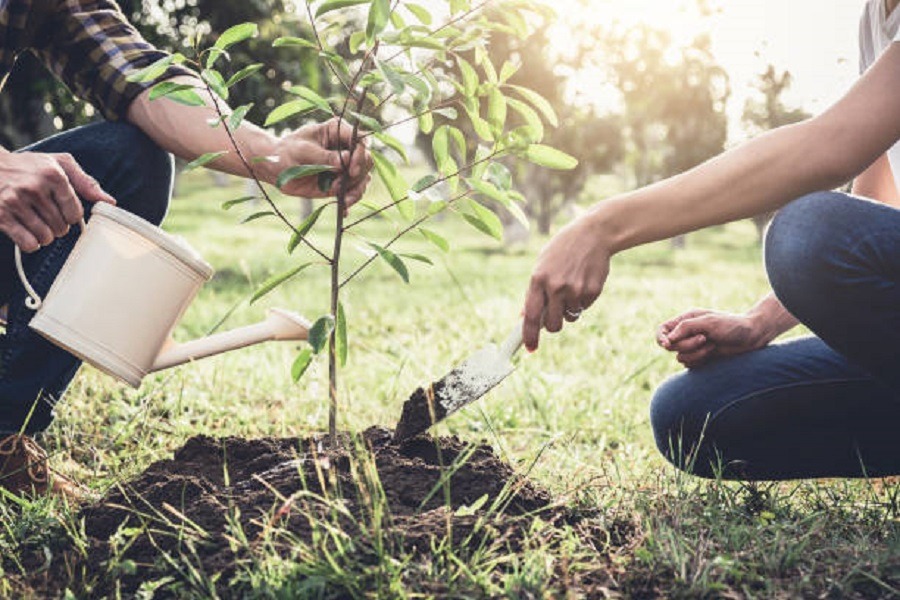Cost to Plant Tree

Cost to Plant Tree
Planting a tree might seem like a simple task, but it involves more than just digging a hole and placing the tree inside. A major aspect of planting a tree is the associated cost. This cost varies depending on several factors, including the type of tree, the size of the tree, location and transportation costs.
Type of Tree
- Fruit trees such as apple or cherry can run between $20 to $100.
- Ornamental trees like Japanese Maple can cost anywhere from $50 to $500.
- Shade trees like Oak or Maple are priced between $40 and $200.
Size of Tree
Size is another significant factor in determining the cost to plant a tree. Generally, larger trees cost more as they require more resources and effort in planting and maintaining.
- Small Trees (4 to 6 feet): These typically range from $50 to $200.
- Medium Trees (8 to 10 feet): These are generally priced between $200 and $800
- Large Trees (12 feet or more): These can run anywhere from $800 up to several thousand dollars.
Location and Transportation Costs
The location where you plan on planting your tree also has an impact on costs. If you’re planting in an urban area with limited access or difficult soil conditions, costs may increase due to additional labor required. Furthermore, if your chosen tree needs transporting from a nursery, there will be added transportation costs that will depend on distance travelled.
Additional Costs
- Tree Maintenance: After planting, your new tree will need regular watering, fertilizing, and possibly, pruning. These maintenance costs can add up over time.
- Protection Measures: Depending on the area, you might need to install protective measures like deer netting or bamboo straws mulch to protect young trees. These will add to your overall cost.
- Landscaping: You might also need to invest in topsoil, compost or mulch for your tree planting project.
In summary, the cost to plant a tree is influenced by several factors — from the type and size of tree you choose to the location where you want it planted and even ongoing maintenance costs. It’s important to consider all these elements when budgeting for your tree planting project — remember that trees are not just an aesthetic addition but also an investment in our planet’s future.
Cost to Plant Tree
When considering the cost of planting a tree, there are several factors you need to take into account. These include the type and size of the tree, preparation of the site, labor costs, aftercare and any additional equipment or supplies that may be needed.
Type and Size of the Tree
The type and size of the tree will significantly impact the total cost. For instance, smaller trees that can be hand planted may only cost around $50-$200. However, larger trees that need machinery for planting could cost anywhere from $500-$1000.
- Shade Trees: $50-$200
- Fruit Trees: $100-$500
- Evergreen Trees: $200-$500
- Flowering Trees: $150-$300
- Bamboo Straws (for use as stakes): $5-$20 per pack.
Preparation of the Site
The site where you plan to plant your tree also plays a significant role in determining overall costs. If the site is clear and ready for planting, then costs remain low. However, if landscaping or removal of existing trees or stumps is required, this will add to your overall expenses.
Labor Costs
Labor costs can vary depending on whether you plant the tree yourself or hire a professional. DIY planting can save money but remember factor in your time. If you’re hiring professionals, they typically charge per hour or per tree depending on their pricing structures.
Aftercare
Aftercare costs include watering equipment (if you don’t already have it), mulch (to protect roots and retain moisture), and potentially fertilizer or pest control depending on your area’s conditions and type of tree.
Additional Equipment
For larger trees or more complex projects, additional equipment like root barriers or support systems might be required which will add to overall costs.
In summary, while planting a tree can seem like a simple task, the overall cost is influenced by various factors. It’s essential to consider all these aspects before jumping in to ensure you budget correctly for your tree planting project.
Cost to Plant Tree
Planting a tree can be a fulfilling experience, but it’s essential to understand the costs involved. Trees not only provide shade and beauty, they also help combat climate change by absorbing carbon dioxide. However, planting a tree isn’t as simple as digging a hole and dropping in a seedling; there are expenses associated with obtaining the tree, preparing the ground, and maintaining the tree after it’s planted.
Initial Costs
- Seedlings or saplings: $20 – $50
- Young trees (5-6 feet tall): $50 – $200
- Mature trees (10-15 feet tall): $200 – $1,000+
Next comes site preparation costs. This could involve tools for digging holes like shovels or augers which could cost between $20-$100 based on quality and complexity. If you need soil amendments like compost or fertilizer, factor in an additional $10-$30.
Installation Costs
- Small trees: $75 – $150 per tree
- Medium trees: $150 – $450 per tree
- Large trees: $400 – 1,000+ per tree
These prices usually include site preparation and post-installation cleanup.
Maintenance Costs
After your tree is planted, it will need regular care which might include watering systems (hose or sprinkler), mulch for protecting its base ($5-$50), pruning shears for maintenance ($20-$100), or even services from professional arborists if needed ($150-$450 annually).
Moreover, if you want to make your garden more sustainable by using eco-friendly tools such as bamboo straws for watering or organic mulch, there might be some additional costs involved.
Hidden Costs
There are also hidden costs that could arise in the future. For example, if a tree grows too close to a building or power line, it may need to be removed, which can cost anywhere from $200 – $1,500 depending on its size and location. Also consider potential pest control costs to protect your tree from infestations.
While the cost to plant a tree can add up, it’s essential to remember that this investment goes beyond money. Trees enhance our environment in numerous ways and can give back more than we put in over their lifetime.
Cost to Plant Tree
Planting a tree involves various cost factors which aren’t always obvious. From the price of the tree itself to the cost of ongoing maintenance, it’s essential to understand these costs before you begin your planting project.
Cost Factors
- Type of Tree: The species of tree you decide to plant can greatly impact the cost. For instance, planting a smaller and more common tree like an apple tree can be quite inexpensive, whereas choosing an exotic or large species such as a mature oak may be significantly more costly.
- Tree Size: The size and maturity of the tree you select will also affect the price. Larger, more mature trees are pricier but provide instant shade and aesthetic appeal. Smaller, younger trees are typically cheaper but will take years to reach their full size.
- Location: Your geographical location can drive up prices as well. Some areas have higher labor costs or might require specific trees that could increase your total expenditure.
- Preparation and Planting Process: Site preparation is another important aspect to consider in your budgeting. If there is a need for ground clearance, soil amendment or irrigation system installation in your chosen planting location, these steps add extra expenses.
Average Costs
- Small Tree: These typically range from $150 – $400 including labor and materials.
- Medium Tree: Medium sized trees generally cost between $200 – $1,000.
- Large Tree: These are usually priced anywhere from $1,000 – $3,000.
Please note that these prices are estimates and actual costs can vary significantly based on the previously discussed factors.
Saving Money on Tree Planting
- Plant in Bulk: If you plan to plant multiple trees, bulk purchases can often reduce the per-tree cost significantly.
- Consider Smaller Trees: While larger trees offer immediate impact, smaller trees are much more affordable and can still provide great benefits over time.
- Do it Yourself: While professional planting services have their advantages, doing the work yourself can save on labor costs. Just ensure you’re aware of best practices to avoid damaging your new tree or your property.
Interestingly, bamboo straws are quickly gaining popularity as a sustainable alternative to plastic straws. Not only is bamboo a highly renewable resource, but the process of growing and harvesting it has a very low carbon footprint compared to other materials. This is another benefit to consider when choosing what type of tree to plant.
Final Thoughts
Understanding the costs associated with planting a tree is important before undertaking such a project. From choosing the right type of tree to factoring in labor and maintenance costs, being equipped with this knowledge will help you make an informed decision that suits both your budget and landscaping goals. Whether you’re looking for quick shade from a mature oak or contributing towards sustainability by planting bamboo for straws, be mindful that every choice carries its own unique costs and benefits.
Cost to Plant a Tree
The cost to plant a tree can vary significantly depending on several factors. These include the type of tree, its size, the location where it’s going to be planted, and the method of planting. Below is a breakdown of these costs.
Type of Tree
- Fruit trees (like apple or pear): $20 – $100
- Ornamental trees (like dogwood or redbud): $30 – $150
- Shade trees (like oak or maple): $60 – $500
- Evergreen trees (like pine or spruce): $40 – $500
It’s important to note that these prices vary significantly by region and availability.
Size of Tree
The size of the tree greatly affects its cost. Smaller saplings are cheaper and easier to plant, but they take longer time to grow. On the other hand, larger more mature trees provide instant gratification as they’re already well grown, but they require special equipment and labor for planting which can increase the costs.
Location
Planting in an easily accessible location will be cheaper compared to difficult terrains that may need professional help for planting. The farther away from a nursery you are located, the higher your delivery charges would be.
Method of Planting
There are two primary methods for planting trees: container-grown and bare-root. Container-grown trees are typically more expensive because they’re usually larger and already somewhat established; however, they also have a higher survival rate after planting because their root system is undisturbed during transport. Bare-root trees are usually less expensive but require more care when being planted.
Labor and Additional Costs
Labor costs can also impact the total cost of planting a tree. If you’re doing the work yourself, this can be a significant saving. However, if you’re hiring a professional, expect to pay anywhere from $50 to $500 for labor, depending on the complexity of the job.
Additional costs might include soil amendments (like compost or fertilizer), mulch, tree supports (like stakes or wire), and watering equipment. Depending on the specific situation and needs of the tree, these could add anywhere from $25 to $100 or more to the total cost.
Planting trees is a sustainable and eco-friendly act. It is similar to using bamboo straws instead of plastic ones. Both contribute towards preserving our environment by reducing carbon footprint and plastic waste. So while considering the cost to plant a tree it’s worthwhile to remember that it’s an investment towards not only beautifying your landscape but also towards building a healthier planet for future generations.
Tags:
